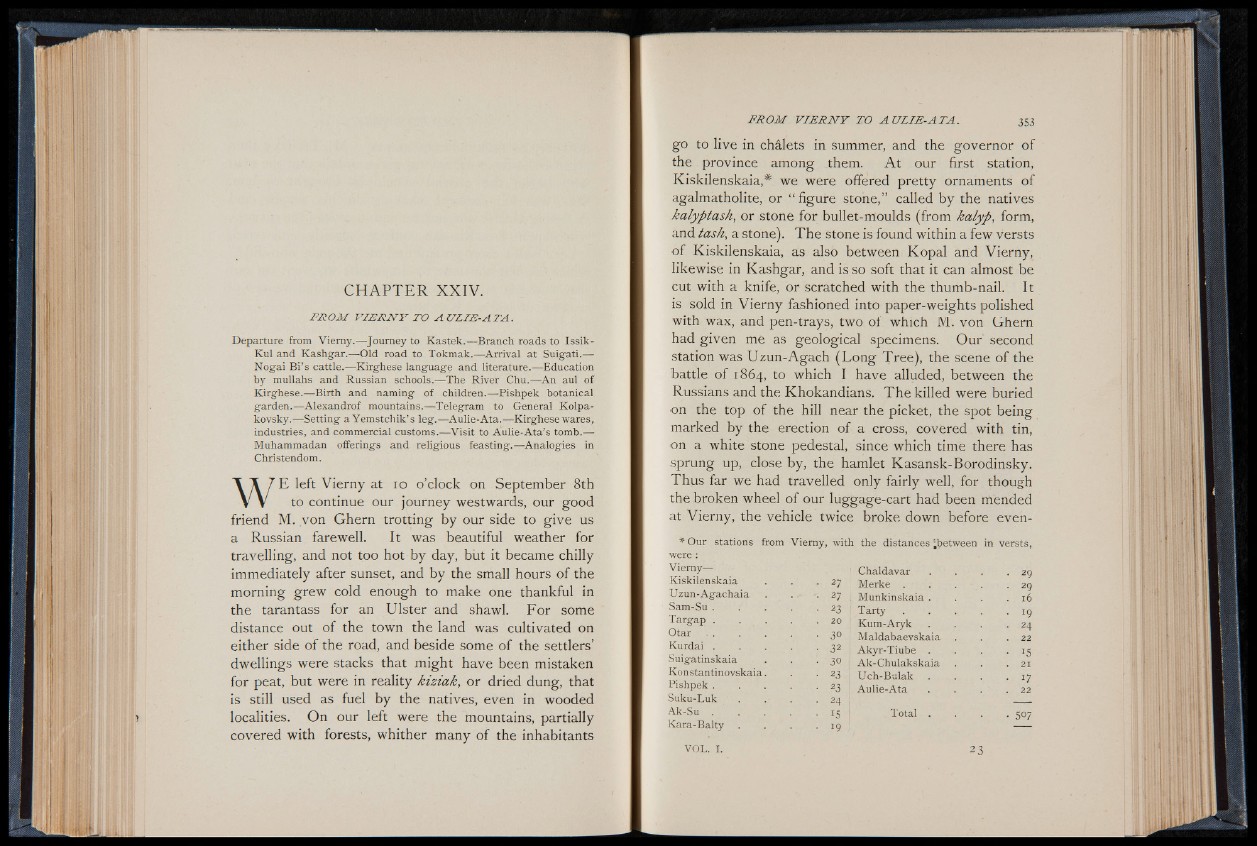
C H A P T E R X X IV .
F R OM V IE R N Y TO A U L IE -A T A .
Departure from Viem y.— Journey to Ka s tek .— Branch roads to Issik-
Kul and Kashgar.— Old road to Tokmak.— Arrival at S u ig a t i i^
Nogai Bi’ s cattle.-— Kirghese language and literature.— Education
by mullahs and Russian schools.— The River Chu.— An aul of
Kirghese.— Birth and naming of children.—-Pishpek botanical
garden.— Alexandrof mountains.— Telegram to General Kolpa-
kovskyE-Setting aYem stch ik’ s leg .— Aulie-Ata.— Kirghese wares,
industries, and commercial customs.— Visit to Aulie-Ata’s tomb.—
Muhammadan oiferings and religious feasting.— Analogies in
Christendom.
WE left Vierny at 10 o’clock on September 8th
to continue our journey westwards, our good
friend M. von Ghern trotting by our side to give us
a Russian farewell. It was beautiful weather for
travelling, and not too hot by day, but it became chilly
immediately after sunset, and by the small hours of the
morning grew cold enough to make one thankful in
the tarantass for an Ulster and shawl. For some
distance out of the town the land was cultivated on
either side of the road, and beside some of the settlers’
dwellings were stacks that might have been mistaken
for peat, but were in reality kiziak, or dried dung, that
is still used as fuel by the natives, even in wooded
localities. On our left were the mountains, partially
covered with forests, whither many of the inhabitants
go to live in chalets in summer, and the governor of
the province among them. A t our first station,
Kiskilenskaia,* we were offered pretty ornaments of
agalmatholite, or “ figure stone,” called by the natives
kalyptash, or stone for bullet-moulds (from kalyp, form,
and task, a stone). The stone is found within a few versts
o f Kiskilenskaia, as also between Kopal and Vierny,
likewise in Kashgar, and is so soft that it can almost be
cut with a knife, or scratched with the thumb-nail. It
is sold in Vierny fashioned into paper-weights polished
with wax, and pen-trays, two of which M. von Ghern
had given me as geological specimens. Our second
station was Uzun-Agach (Long Tree), the scene of the
battle of 1864, to which I have alluded, between the
Russians and the Khokandians. The killed were buried
on the top of the hill near the picket, the spot being
marked by the erection of a cross, covered with tin,
on a white stone pedestal, since which time there has
sprung up, close by, the hamlet Kasansk-Borodinsky.
Thus far we had travelled only fairly well, for though
the broken wheel of our luggage-cart had been mended
at Vierny, the vehicle twice broke down before even-
* Our stations from Vierny,
with the distances ^between in versts,
were :
Viemy-ft®
! Chaldavar . . 29
Kiskilenskaia
Uzun-Agachaia
Sam-Su .
Targap .
Otar
Kurdai .
Suigatinskaia
Konstantinovskaia
Pishpek .
Suku-Luk
Ak-Su .
Kara-Baity
27 Merke . . . 29
2 7 i Munkinskaia . . 16
23 I Tarty . 19
20 Kum-Aryk . 24
3° Maldabaevskaia . 22
3 2 j Akyr-Tiube . • i f
3° Ak-Chulakskaia . 21
23 Uch-Bulak . • r7
23 j Aulie-Ata . 2 2
24 j -----
15 . Total . • 507
19 ! ---
VOL. I. 23